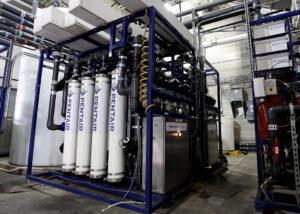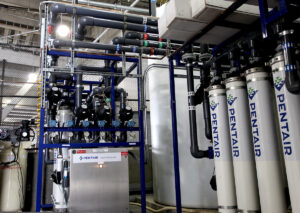Pentair, a global company with its main U.S. office in Minneapolis, has recently refocused its efforts squarely on the water sector. The company’s water technology has broad applications in the residential, commercial, and industrial sectors. Pentair also helped the Minnesota Twins achieve Leadership in Energy and Environmental Design (LEED) certification for their new baseball stadium with an innovative, facility-scale rainwater capture and reuse installation as well as purified drinking water stations.
In this interview, Phil Rolchigo, Pentair’s chief technology officer, speaks with Municipal Water Leader Managing Editor Joshua Dill about Pentair’s history, its project at Target Field, and its vision for the future.
Joshua Dill: Please tell us about your background and how you came to be in your current position.
Phil Rolchigo: I received a PhD in chemical engineering in 1988 and have been in the water treatment space ever since. I helped found a startup company and developed some advanced technologies for wastewater treatment that we applied to industrial applications. We sold that company to a company called Osmonics, one of the pioneers in the use of membrane technology to treat drinking and industrial water, where I became the chief executive officer. I worked with that company for a number of years, then sold it to General Electric (GE). That was a time when multinationals became extremely interested in water, and GE made significant investments in building its own water platform. After working with GE for about 4 years, I had the opportunity to come over to Pentair. I really admired Pentair’s vision when it came to water, and joined to lead technology for its water group. At that time, it was a multi-industrial company focused on electrical products and water technology. Over the course of the 12 years that I’ve been with Pentair, it has grown and transitioned a number of times, and about a year ago it separated its electrical business to become a pure-play water company. At that time, I became the company’s chief technology officer.
Joshua Dill: Would you give a basic overview of Pentair as a company?

Phil Rolchigo: Pentair was founded in 1966. At the time, the aim was to create weather balloons to monitor weather. Since then, the company has reinvented itself several times, with the most recent transition being the separation of our electrical businesses, which is now a company called nVent. We have about $3 billion in revenue, approximately 110 locations in 30 different countries, and 10,000 employees. Our revenue comes from three segments. One is our aquatic systems business, which focuses on residential and commercial pool technologies. The second segment is our flow technologies business, which includes pumps and controls for everything from residential applications, like sump pumps in homes or off-grid drinking water well pumps, to commercial and municipal applications for water transport and wastewater disposal. Our third segment is what we call our filtration solutions business. This group develops new technologies to treat water and wastewater for residential, commercial, industrial, and food and beverage applications. I would say that nearly 80 percent of Pentair’s $3 billion revenue is derived from the residential and commercial markets and the other approximately 20 percent is derived from the industrial and municipal markets. Our brand promise is to deliver smart, sustainable water solutions for life. Since Pentair’s transition to a pure-play water company, our strategy and mission have become much more clearly focused. It is an exciting journey.
Joshua Dill: Would you tell me about Pentair’s facilities in the Minnesota Twins’ stadium?
Phil Rolchigo: Back when the Twins were going to be opening Target Field, they had the vision of having the stadium meet the LEED Silver standard. Considering the different ways to achieve that certification, they realized that water use presented a huge opportunity. We put our creativity to work to find a way to improve the stadium’s water footprint and reduce its water consumption. When we looked at the way they were collecting and managing the rainwater, we saw that water was draining through the field, running through a conduit into a cistern that runs along the warning track on the field, and then flowing through a series of weirs into the Mississippi River. We realized that we could capture that water, process it, purify it, and then reuse it.
Designing that system was a unique challenge. After performing a water balance on the cistern, we realized we could collect about 2 million gallons of water a year. We designed a system with multiple levels of filtration. Our proprietary pretreatment technology removes the suspended solids. This is followed by our proprietary ultrafiltration technology, which filters the water down to a level of .01 microns, removing a fair amount of high-molecular-weight organic matter and purifying the water to eliminate biopathogens such as bacteria and viruses. Then we disinfect the water with chlorine and ultraviolet light and store it in a holding tank. At that point, a pump distribution network delivers that water to points in the stadium, where it is typically used to wash down the seating bowl. After it is used to clean the stadium, it drains back to the municipal wastewater treatment plant. We’ve been doing this for about 10 years, and we’ve captured and reused about 20 million gallons of rainwater in total. Not only did we reduce the municipal water footprint by 20 million gallons over this period, but maybe even more importantly, we eliminated 20 million gallons of untreated water from flowing into and contaminating the Mississippi River.
It’s been a great partnership, and we really appreciate the Twins’ vision of constantly improving the sustainability of the stadium. They have now achieved LEED Gold certification for operations and maintenance. In 2019, they also achieved LEED Gold certification for leadership in energy and environmental design. In this past year, we worked with them to install Pentair filtration technology in the drinking water systems throughout their stadium. The Twins encourage their fans to bring reusable water bottles into the stadium and drink filtered water instead of buying bottled water, thus reducing plastic waste.
Joshua Dill: Has the stadium project introduced more people to your products and services?
Phil Rolchigo: We’ve had tremendous response via social media. People really appreciate the effort. Nearly 80 percent of what we do is in the residential and commercial markets, where there is a tremendous opportunity to use our technology to minimize the bottled water footprint. Our facilities are water bottle free. We have our own water treatment technologies in our facilities so that, whether they’re in Mexico, China, or here in Minneapolis, our employees are getting high-quality and great-tasting water from Pentair technology.
Joshua Dill: Have you built any other similar projects?
Phil Rolchigo: Rainwater capture and recycling is still in its infancy. When we developed the system at the stadium 10 years ago, we were ahead of the curve. When new commercial buildings are being designed, many times no one is even thinking about these applications. There’s still a lot of work to be done to incentivize and raise awareness of the importance of rainwater capture and reuse systems.
Where we are finding tremendous traction is in industrial reuse applications. Food and beverage plants in particular generate a tremendous amount of organic waste in their wastewater. We’ve been finding that by applying a combination of membrane technology and biological treatment and, increasingly, anaerobic biological treatment, we’re able to take what is considered waste and use it as a feed stock to generate energy and clean water. It is recycled and reused onsite. You can draw a clear economic and environmental value proposition around those applications. When it comes to commercial and rainwater reuse applications, it’s harder to draw the economic value proposition, but you can clearly draw the environmental and social value propositions around them.

Joshua Dill: Would you tell us about your vision for the future?
Phil Rolchigo: More and more, we’re finding that homeowners want to take control of their own destinies and assume accountability for their water. There is significant infrastructure that needs to be put in place in the United States to rebuild our piping networks, upgrade our drinking water treatment plants, and improve our wastewater treatment plants. With that in mind, our Pentair technologies can assist homeowners in taking control of their water quality and help ensure that they are getting great-quality and great-tasting water right at the point of entry in their homes or at the point of use in the sink. We’re continually developing better and more-effective technology to do that.
We’re also really excited about opportunities in the commercial sector. Fit-for-purpose water is an exciting, niche application that makes a lot of sense—developing water with the right composition to make great-tasting coffee, great pizza dough, or great bagels.
Also, in each of the markets that we serve, we are trying to make our products smart by implementing Internet-of-things-enabled, real-time analysis of how they’re performing. This is an area in which we’re making significant investments.
Phil Rolchigo is chief technology officer of Pentair. For more information, visit pentair.com.
